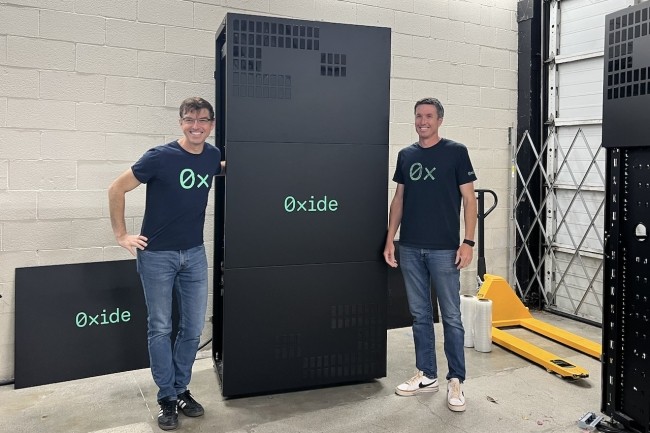Private Cloud is the New Hotness
Last week I participated as a delegate at Cloud Field Day 24. If I had to pick a common thread that wove through the sessions, it would be enabling private cloud. The presentation from Oxide took that to the extreme, as they outlined their vision of a cloud computer that you deploy in your own datacenter.
I first heard about Oxide two years ago, so I was excited to learn more about this vendor first hand. The session was held at Oxide’s headquarters in Emeryville, CA. Their space has the classic Silicon Valley hardware startup vibe: half office and half mad scientist lab. Visual references, books and artifacts from the history of computer development add to the vibe.
Steve Tuck, the co-founder and CEO of Oxide kicked things off by outlining Oxide’s vision. In short, they are breaking the mold for what on-premises compute infrastructure traditionally looks like. Instead, they are building computers that look and behave just like the ones that the public cloud hyper-scalers are building.
A Cloud Computer for your Datacenter
Why are they doing this? Bryan Cantrill, Oxide’s co-founder and CTO outlines their founding beliefs in the 2023 blog post “The Cloud Computer“:
- Cloud computing is the future of all computing infrastructure.
- The computer that runs the cloud should be able to be purchased and not merely rented.
- Building a cloud computer necessitates a rack-level approach – and the co-design of both hardware and software.
Oxide’s approach stands in stark contrast to the traditional rack-and-stack infrastructure model. In that model IT infrastructure teams are integrating off the shelf products from multiple vendors. More often than not they end up dealing with all the integration problems that come along with that traditional approach. As Steve outlined during his talk, this traditional approach often results in a lot of finger pointing by the different vendors, with IT stuck in the middle to mediate. As someone with over twenty years of data center deployment experience, I could strongly relate to this statement.
A Clean Sheet Approach
Up next was Bryan Cantrill, Oxide’s CTO, to give the delegates a deep dive into Oxide’s clean sheet approach to designing a cloud scale computer. He outlined some of the key technical advantages of their design:
- A DC power rail to handle power distribution to all components, an approach that is 12x more power efficient than traditional rack-and-stack.
- No cabling required for their compute sleds, significantly reducing time to deployment.
- 80mm fans running at 2K RPM that results in a rack that is whisper quiet.
- No third party BIOS! An attack surface that is commonly exploited is eliminated.
- A built-in hardware root of trust.
- Fully integrated software for managing the platform via web console, CLI, or API, with all code being completely open-source.
What Oxide provides is a pre-assembled and scalable compute infrastructure that you can roll into your data center and have up and running for your developers in just one hour.
My Takeaways
As a hardware geek, I absolutely love what Oxide is doing here. They have taken all the lessons learned from what the hyper-scalers have been doing and delivering a tightly integrated package that is modular and easy to expand as you grow. Additionally, at a time when supply chain attacks are becoming more common, their approach to hardware sourcing and secure computing is highly appealing.
As a cloud computing advocate, I love the open API and integrations with Kubernetes, Grafana, and Terraform and more. This is a great approach that allows me to manage my on-premises compute using the same tooling and processes that I use to manage in the public cloud.
The closest thing I’ve seen to their solution would be something like Amazon Outposts. However the Oxide team were quick to challenge that comparison, citing the fact that Outposts is a rental model. A fair point, but one advantage that Outposts has is that one could start much smaller and still get a lot of the cloud-like user experience.
Pricing is the big question
One topic that was not discussed during the presentation was price. Nor could I find any pricing information on Oxide’s website. At this point, Oxide has a relatively small number of customers and their product is fairly bespoke. I can only assume that the pricing is out of reach for most small to medium enterprises.
The target customers at this stage would be very large enterprises that are looking to repatriate a very large cloud footprint or built out huge private compute environments. Think big tech / AI companies, federal national labs, financial services and the like. These types of customers have deep enough pockets to make the investment. The big question is will these types of companies be willing to invest in such a tightly integrated single vendor solution?
I know that I’m not likely to ever be working at place that can afford to deploy this product. Yet I still admire what Oxide is doing here and I will continue to watch their progress with great interest. Here’s hoping some more vendors will appear in the landscape that will take a similar approach to building next generation computing infrastructure.


